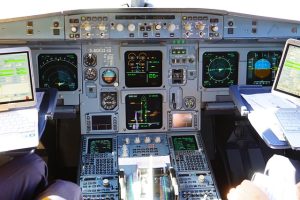
Have you heard of avionics? Whether you work in the aviation industry, or if you’re a recreational pilot, you may come across this term. The term “avionics” was originally coined by Phillip Klass during the mid-1900s. Since then, it has been a fundamental concept in the field of aerospace engineering. What is avionics exactly?
The Basics of Avionics
Avionics consists of the electrical devices and electrical systems in airplanes. It combines the terms “aviation” and “electronics.”
All modern-day airplanes — along with other types of aircraft like helicopters — have electrical devices and electrical systems. They play an important role in the safety and overall performance of airplanes. Avionics encompasses all of the electrical devices and systems.
Flight Control Systems
Flight control systems fall under the category of avionics. Also known as an aircraft flight control system (AFCS), it features all of the controls that allow pilots to navigate and control the airplane. A typical flight control system features a control yoke, rudder pedal, throttle and other associated controls.
Navigation Systems
In addition to a flight control system, most airplanes have a navigation system, both of which fall under the category of avionics. The difference lies in their purpose. Flight control systems allow pilots to control the airplane, whereas navigation systems are used for navigation purposes. Common components of a navigation system include Global Positioning System (GPS) and Inertial Navigation System (INS).
Weather Systems
Some modern-day airplanes are equipped with a weather system. Weather systems are designed to sense and relay information about the weather. There are radar-based weather systems that, as the name suggests, use radar to analyze the weather. They emit beams of energy that strike water droplets. Upon striking the water droplets, the energy waves will bounce back to the airplane. With a weather system, pilots can avoid pockets of areas of severe weather.
Communication Systems
Avionics includes communication systems. When flying, pilots must be able to communicate with air traffic control as well as other pilots. Therefore, they are equipped with a communication system. Common components of a communication system include the radios and transponders. Using these components, pilots can communicate with air traffic control and other pilots in the surrounding airspace.
In Conclusion
There are mechanical systems on airplanes, and there are electrical systems. Avionics encompasses the latter. It consists of flight control systems, navigation systems, weather systems, communication systems and more.



